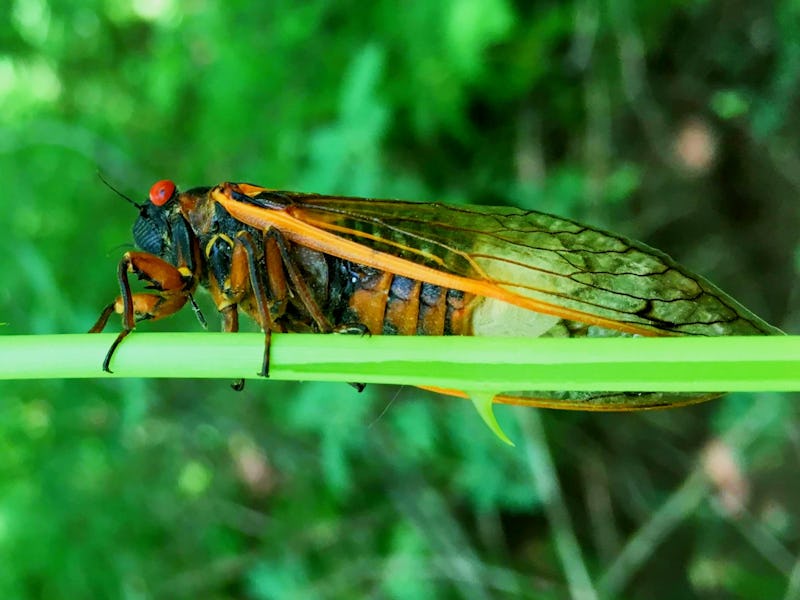"Zombie Cicada" Mystery Solved by Hallucinogenic Fungus Researchers
"I wouldn't take that risk."

Like a buzzing embodiment of Wagner’s “Ride of the Valkyries,” periodical cicadas emerge from the ground in swarms after spending more than a decade below ground. Some, however, encounter an attacker during their crawl to the surface: a deadly fungus named Masspora cicadina. According to research in Fungal Ecology, this fungus not only destroys the cicada’s bodies but warps their minds with a psychedelic chemical and a strong stimulant.
"They are only zombies in the sense that the fungus is in control of their bodies."
The research, part of the journal’s October issue but available online now, zeroed in on why Masspora cicadina is so damaging and how it spreads. The fungus can cause the cicadas to lose some of their limbs and consumes their genitals and butts. Eventually, parts of their abdomen break away, revealing an inner plug of white fungi.
Remarkably, this nightmare doesn’t keep them from doing the dirty — in fact it helps keep the nightmare going. During the few weeks that the adult cicadas are alive above ground, the infected continue their mating attempts — and when a diseased cicada makes contact with another, the viscous spores spread.
“They are only zombies in the sense that the fungus is in control of their bodies,” says co-author and West Virginia University professor Matthew Kasson, Ph.D.
Once the abdomen falls off, all that's left there is a mass of spores.
Massopora cicadina are one of the few species of entomopathogenic fungi that keep their hosts alive while they continue to sporulate — a process that enhances the dispersal of the spores. But Kasson and colleagues note that “the mechanisms underlying active spore transmission … in living insects remain elusive.”
That’s where this study comes in. The scientists analyzed infected cicadas for small molecules that could explain the insects’ hyper-sexual behavior and overall demise. Research began in 2016, when billions of cicadas took hold in the northeast. At first, the team tried to conduct their studies by infecting cicadas in the lab, but when that method didn’t work, they captured infected cicadas in the wild.
The analysis revealed that the Massopora infecting the cicadas contained two powerful chemicals: psilocybin (the active ingredient in “magic mushrooms”) and the stimulant cathinone (synthetic cathinones are what we know as “bath salts.”) Cathinone is a type of amphetamine and hasn’t been found before in fungi. Previously, cathinone has only been found in the khat plant, a shrub that grows in East Africa and southern Arabia.
“The neurogenic activities of these compounds,” the scientists write, “suggest the extended phenotype of Massopora that modifies cicada behavior to maximize dissemination is chemically induced.”
While this finding explains the cicadas’ crazy behavior, it doesn’t offer a means to keep the cicadas from becoming amorous death vehicles. Kasson does note, however, that it’s not out of the realm of possibility to get a little high from the butt of an infected cicada, if that’s your sort of thing.
“Maybe [you can get high] if you’re motivated enough,” Kasson divulged. “These psychoactive compounds were just two of less than 1,000 compounds found in these cicadas. Yes, they are notable but there are other compounds that might be harmful to humans.”
“I wouldn’t take that risk.”
Abstract:
Entomopathogenic fungi routinely kill their hosts before releasing infectious spores, but a few species keep insects alive while sporulating, which enhances dispersal. Transcriptomics- and metabolomics-based studies of entomopathogens with post-mortem dissemination from their parasitized hosts have unraveled infection processes and host responses. However, the mechanisms underlying active spore transmission by Entomophthoralean fungi in living insects remain elusive. Here we report the discovery, through metabolomics, of the plant-associated amphetamine, cathinone, in four Massospora cicadina-infected periodical cicada populations, and the mushroom-associated tryptamine, psilocybin, in annual cicadas infected with Massospora platypediae or Massospora levispora, which likely represent a single fungal species. The absence of some fungal enzymes necessary for cathinone and psilocybin biosynthesis along with the inability to detect intermediate metabolites or gene orthologs are consistent with possibly novel biosynthesis pathways in Massospora. The neurogenic activities of these compounds suggest the extended phenotype of Massospora that modifies cicada behavior to maximize dissemination is chemically-induced.